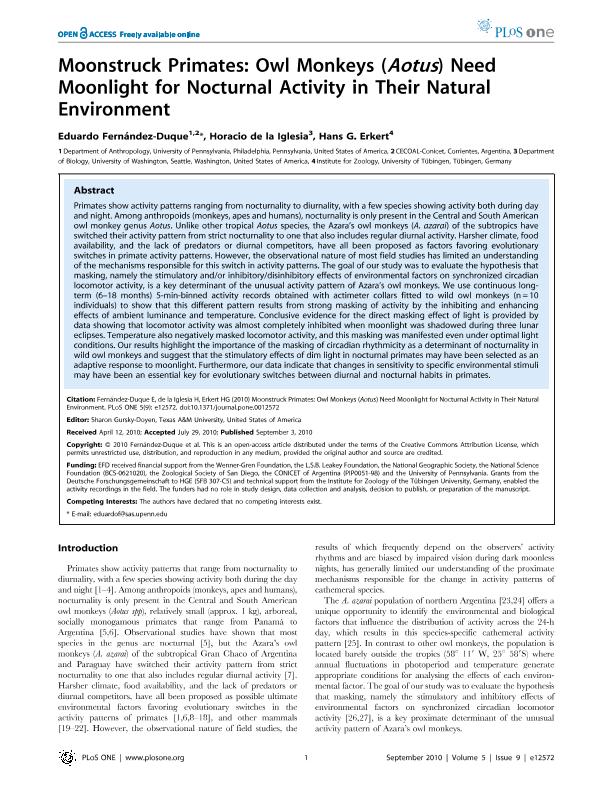Mostrar el registro sencillo del ítem
dc.contributor.author
Fernandez Duque, Eduardo

dc.contributor.author
de la Iglesia, H.
dc.contributor.author
Erkert, H. G.
dc.date.available
2020-03-17T16:32:28Z
dc.date.issued
2010-09
dc.identifier.citation
Fernandez Duque, Eduardo; de la Iglesia, H.; Erkert, H. G.; Moonstruck Primates: Owl Monkeys (Aotus) Need Moonlight for Nocturnal Activity in Their Natural Habitat; Public Library of Science; Plos One; 5; 9; 9-2010; 1-6
dc.identifier.issn
1932-6203
dc.identifier.uri
http://hdl.handle.net/11336/99834
dc.description.abstract
Primates show activity patterns ranging from nocturnality to diurnality, with a few species showing activity both during day and night. Among anthropoids (monkeys, apes and humans), nocturnality is only present in the Central and South American owl monkey genus Aotus. Unlike other tropical Aotus species, the Azara's owl monkeys (A. azarai) of the subtropics have switched their activity pattern from strict nocturnality to one that also includes regular diurnal activity. Harsher climate, food availability, and the lack of predators or diurnal competitors, have all been proposed as factors favoring evolutionary switches in primate activity patterns. However, the observational nature of most field studies has limited an understanding of the mechanisms responsible for this switch in activity patterns. The goal of our study was to evaluate the hypothesis that masking, namely the stimulatory and/or inhibitory/disinhibitory effects of environmental factors on synchronized circadian locomotor activity, is a key determinant of the unusual activity pattern of Azara's owl monkeys. We use continuous long-term (6-18 months) 5-min-binned activity records obtained with actimeter collars fitted to wild owl monkeys (n= 10 individuals) to show that this different pattern results from strong masking of activity by the inhibiting and enhancing effects of ambient luminance and temperature. Conclusive evidence for the direct masking effect of light is provided by data showing that locomotor activity was almost completely inhibited when moonlight was shadowed during three lunar eclipses. Temperature also negatively masked locomotor activity, and this masking was manifested even under optimal light conditions. Our results highlight the importance of the masking of circadian rhythmicity as a determinant of nocturnality in wild owl monkeys and suggest that the stimulatory effects of dim light in nocturnal primates may have been selected as an adaptive response to moonlight. Furthermore, our data indicate that changes in sensitivity to specific environmental stimuli may have been an essential key for evolutionary switches between diurnal and nocturnal habits in primates.
dc.format
application/pdf
dc.language.iso
eng
dc.publisher
Public Library of Science

dc.rights
info:eu-repo/semantics/openAccess
dc.rights.uri
https://creativecommons.org/licenses/by-nc-sa/2.5/ar/
dc.subject
Aotus
dc.subject
Nocturnal
dc.subject.classification
Otros Tópicos Biológicos

dc.subject.classification
Ciencias Biológicas

dc.subject.classification
CIENCIAS NATURALES Y EXACTAS

dc.title
Moonstruck Primates: Owl Monkeys (Aotus) Need Moonlight for Nocturnal Activity in Their Natural Habitat
dc.type
info:eu-repo/semantics/article
dc.type
info:ar-repo/semantics/artículo
dc.type
info:eu-repo/semantics/publishedVersion
dc.date.updated
2019-05-14T15:53:10Z
dc.journal.volume
5
dc.journal.number
9
dc.journal.pagination
1-6
dc.journal.pais
Estados Unidos

dc.journal.ciudad
San Francisco
dc.description.fil
Fil: Fernandez Duque, Eduardo. Consejo Nacional de Investigaciones Científicas y Técnicas. Centro Científico Tecnológico Conicet - Nordeste. Centro de Ecología Aplicada del Litoral. Universidad Nacional del Nordeste. Centro de Ecología Aplicada del Litoral; Argentina. University of Pennsylvania; Estados Unidos
dc.description.fil
Fil: de la Iglesia, H.. University Of Washington, Seattle;
dc.description.fil
Fil: Erkert, H. G.. Universität Tübingen; Alemania
dc.journal.title
Plos One

dc.relation.alternativeid
info:eu-repo/semantics/altIdentifier/url/https://journals.plos.org/plosone/article?id=10.1371/journal.pone.0012572
dc.relation.alternativeid
info:eu-repo/semantics/altIdentifier/doi/https://doi.org/10.1371/journal.pone.0012572
Archivos asociados
